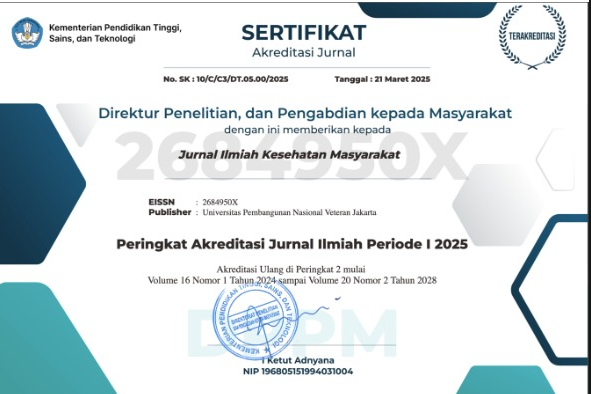Leadership Walkrounds dalam Meningkatkan Budaya Keselamatan Pasien di Rumah Sakit: Scoping Review
Abstract
Latar Belakang: Pelayanan kesehatan di rumah sakit harus mengutamakan mutu pelayanan dan keselamatan pasien. Leadership Walkrounds merupakan metode yang efektif untuk meningkatkan budaya keselamatan pasien dan kualitas pelayanan, melalui komunikasi langsung antara manajer dan karyawan. Hal ini berkontribusi pada pengembangan keterampilan karyawan, menjaga budaya keselamatan pasien, meningkatkan keterlibatan karyawan, dan mengurangi burnout pegawai. Tujuan tinjauan literatur ini adalah untuk mengetahui efektivitas Leadership Walkrounds dalam meningkatkan budaya keselamatan pasien di rumah sakit.
Metode: Studi ini dilakukan dengan metode scoping review dengan pedoman Arksey dan O’Malley. Studi dilakukan dengan mengikutsertakan publikasi dari tahun 2013 hingga 2023. Pencarian literatur dilakukan pada 3 database elektronik menemukan sebanyak 137 artikel yang kemudian menghasilkan 6 artikel yang akan masuk ke dalam tinjauan. Analisis dilakukan dengan mencari dampak dan faktor yang memengaruhi efektivitas Walkrounds.
Hasil: Hasil tinjauan menunjukkan bahwa Walkrounds efektif dalam meningkatkan keselamatan pasien, budaya keselamatan, keterlibatan tenaga kerja, dan mengurangi kelelahan. Implementasi yang tepat dan partisipasi aktif tenaga kerja penting untuk keberhasilan Walkrounds. Walkrounds bukanlah solusi tunggal, pendekatan terintegrasi dan komprehensif juga diperlukan. Komitmen kuat dari pimpinan dan lingkungan yang mendukung komunikasi terbuka, umpan balik, dan kolaborasi sangat penting.
Kesimpulan: Walkrounds membantu mengidentifikasi masalah, mencegah kesalahan, meningkatkan komunikasi tim, dan melibatkan pasien dalam perawatan. Implementasi Walkrounds harus menjadi bagian dari strategi yang lebih luas, dengan pedoman yang jelas, kolaborasi antar organisasi, dan keterlibatan pasien untuk hasil yang optimal.
Kata Kunci: Budaya keselamatan pasien, Leadership walkrounds, Rumah sakit
Background: Healthcare services in hospitals should prioritize the quality of care and patient safety. Leadership walkrounds are an effective method to enhance patient safety culture and service quality through direct communication between managers and employees. It contributes to the development of employee skills, maintaining patient safety culture, improving employee engagement, and reducing burnout. The aim of this review is to assess the effectiveness of Leadership walkrounds in enhancing patient safety culture in hospitals.
Methods: This study was conducted using the scoping review method following the Arksey and O'Malley framework. Publications from 2013 to 2023 were included in the search. Literature search was conducted in 3 electronic databases resulting in a total of 137 studies, which then resulting 6 articles will be included on this study. Analysis was performed on all identified studies, focusing on the impact and factors influencing the effectiveness of walkrounds.
Results: The review findings indicate that Walkrounds are effective in improving patient safety, safety culture, employee engagement, and reducing fatigue. Proper implementation and active employee participation were crucial for the success of Walkrounds. Walkrounds were not a standalone solution; an integrated and comprehensive approach was also required. Strong commitment from leadership and an environment that supports open communication, feedback, and collaboration were highly important.
Conclusion: Walkrounds help identify issues, prevent errors, improve team communication, and involve patients in care. Implementation should be part of a broader strategy, with clear guidelines, interorganizational collaboration, and patient involvement for optimal outcomes.
Keywords: Hospital, Leadership walkrounds, Patient safety culture
References
Westat J, Sorra L, Gray MPHS, Streagle MAT, Famolaro MPSN, Yount J, et al. AHRQ Hospital Survey on Patient Safety Culture: User’s Guide [Internet]. 2016. Available from: http://www.ahrq.gov
De Vries EN, Ramrattan MA, Smorenburg SM, Gouma DJ, Boermeester MA. The incidence and nature of in-hospital adverse events: A systematic review. Qual Saf Health Care. 2008 Jun;17(3):216–23.
Leonard M, Graham S, Bonacum D. The human factor: The critical importance of effective teamwork and communication in providing safe care. Vol. 13, Quality and Safety in Health Care. 2004.
Catalano AS, Redford K, Margoluis R, Knight AT. Black swans, cognition, and the power of learning from failure. Conservation Biology. 2018 Jun 1;32(3):584–96.
Klimmeck S, Sexton JB, Schwendimann R. Changes in Safety and Teamwork Climate After Adding Structured Observations to Patient Safety WalkRounds. Jt Comm J Qual Patient Saf. 2021 Dec 1;47(12):783–92.
Clancy CM, Tornberg DN. TeamSTEPPS: Assuring optimal teamwork in clinical settings. Vol. 22, American Journal of Medical Quality. 2007. p. 214–7.
Frankel A, Grillo SP, Baker EG, Huber CN, Abookire S, Grenham M, et al. Patient Safety Leadership WalkRounds at Partners Healthcare: learning from implementation. Joint Commission journal on quality and patient safety / Joint Commission Resources. 2005;31(8):423–37.
Dhamanti I, Leggat S, Barraclough S. Practical and cultural barriers to reporting incidents among health workers in Indonesian public hospitals. J Multidiscip Healthc. 2020;13:351–9.
Sexton JB, Adair KC, Leonard MW, Frankel TC, Proulx J, Watson SR, et al. Providing feedback following Leadership WalkRounds is associated with better patient safety culture, higher employee engagement and lower burnout. BMJ Qual Saf. 2018 Apr 1;27(4):261–70.
AL Shra’ah DrAEMAS, Rumman MA, Hamour HMJA, Sha"ar IM AL. Practicing Management “By Walking Around” and Its Impact on the Organizational Commitment in the Jordanian Hospitals. Journal of Management Research. 2012 Dec 10;5(1).
Rotteau L, Shojania KG, Webster F. “I think we should just listen and get out”: A qualitative exploration of views and experiences of Patient Safety Walkrounds. BMJ Qual Saf. 2014 Oct 1;23(10):823–9.
Frankel A, Grillo SP, Baker EG, Huber CN, Abookire S, Grenham M, et al. Patient Safety Leadership WalkRounds at Partners Healthcare: learning from implementation. Joint Commission journal on quality and patient safety / Joint Commission Resources. 2005;31(8):423–37.
Meswantri M, Awaludin A. International Review of Management and Marketing Determinant of Employee Engagement and its Implications on Employee Performance. International Review of Management and Marketing [Internet]. 2018;8(3):36–44. Available from: http:www.econjournals.com
Arksey H, O’Malley L. Scoping studies: Towards a methodological framework. International Journal of Social Research Methodology: Theory and Practice. 2005 Feb;8(1):19–32.
Taylor AM, Chuo J, Figueroa-Altmann A, Di Taranto S, Shaw KN. Using four-phased unit-based patient safety walkrounds to uncover correctable system flaws. Jt Comm J Qual Patient Saf. 2013;39(9):396–403.
Martin G, Ozieranski P, Willars J, Charles K, Minion J, McKee L, et al. Walkrounds in practice: Corrupting or enhancing a quality improvement intervention? A qualitative study. Jt Comm J Qual Patient Saf. 2014;40(7):303–10.
Rotteau L, Shojania KG, Webster F. “I think we should just listen and get out”: a qualitative exploration of views and experiences of Patient Safety Walkrounds. Available from: http://dx.doi.org/10.1136/bmjqs-
Sexton JB, Sharek PJ, Thomas EJ, Gould JB, Nisbet CC, Amspoker AB, et al. Exposure to Leadership WalkRounds in neonatal intensive care units is associated with a better patient safety culture and less caregiver burnout. BMJ Qual Saf [Internet]. 2014;23(10):814–22. Available from: https://qualitysafety.bmj.com/lookup/doi/10.1136/bmjqs-2013-002042
Sexton JB, Adair KC, Leonard MW, Frankel TC, Proulx J, Watson SR, et al. Providing feedback following Leadership WalkRounds is associated with better patient safety culture, higher employee engagement and lower burnout. BMJ Qual Saf [Internet]. 2018;27(4):261–70. Available from: https://qualitysafety.bmj.com/lookup/doi/10.1136/bmjqs-2016-006399
Klimmeck S, Sexton JB, Schwendimann R. Changes in Safety and Teamwork Climate After Adding Structured Observations to Patient Safety WalkRounds. The Joint Commission Journal on Quality and Patient Safety [Internet]. 2021;47(12):783–92. Available from: https://linkinghub.elsevier.com/retrieve/pii/S1553725021002348
Rotteau L, Shojania KG, Webster F. “I think we should just listen and get out”: A qualitative exploration of views and experiences of Patient Safety Walkrounds. BMJ Qual Saf. 2014 Oct 1;23(10):823–9.
Leonard M, Graham S, Bonacum D. The human factor: The critical importance of effective teamwork and communication in providing safe care. Vol. 13, Quality and Safety in Health Care. 2004.
Sexton JB, Adair KC, Leonard MW, Frankel TC, Proulx J, Watson SR, et al. Providing feedback following Leadership WalkRounds is associated with better patient safety culture, higher employee engagement and lower burnout. BMJ Qual Saf. 2018 Apr 1;27(4):261–70.
Van Dusseldorp L, Huisman - de Waal G, Hamers H, Westert G, Schoonhoven L. Feasibility and Added Value of Executive WalkRounds in Long Term Care Organizations in the Netherlands. Jt Comm J Qual Patient Saf. 2016 Dec 1;42(12):545-AP3.









.jpg)








